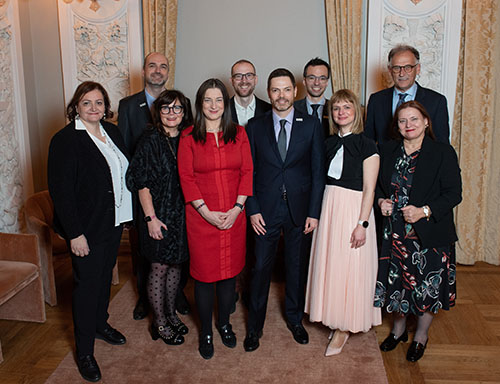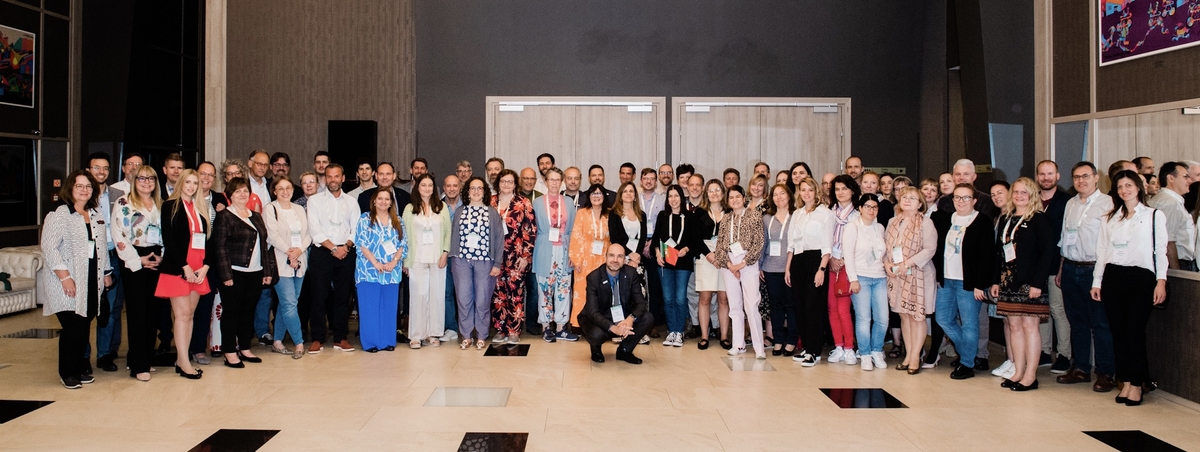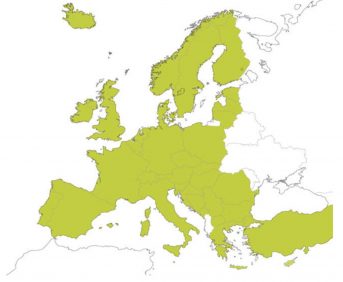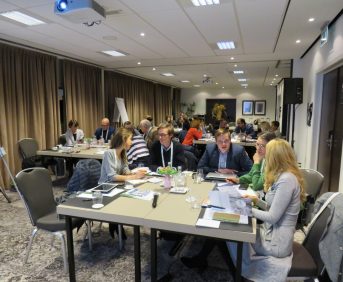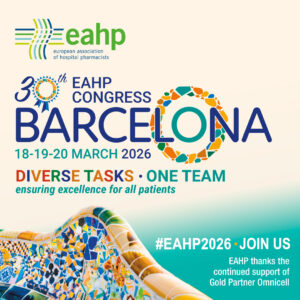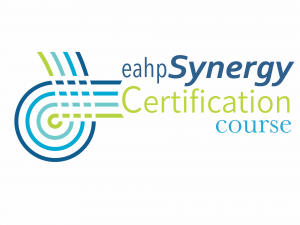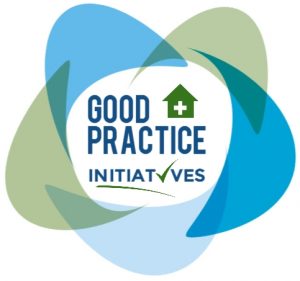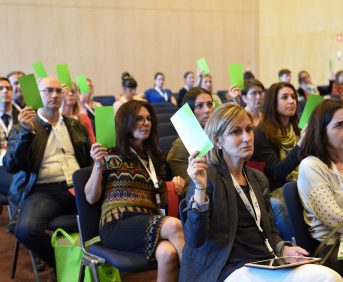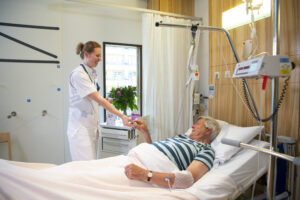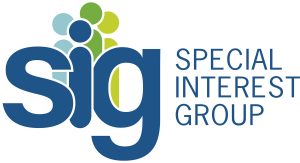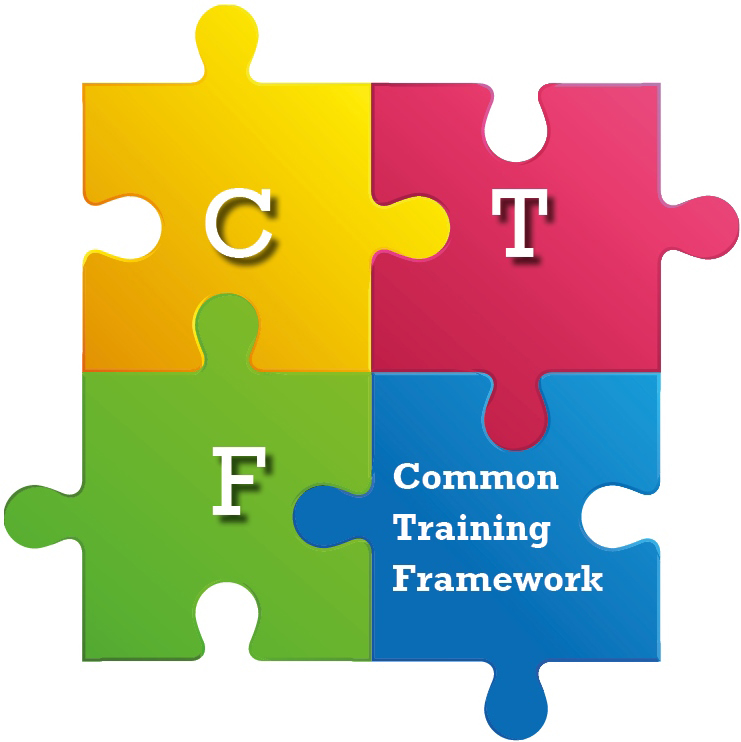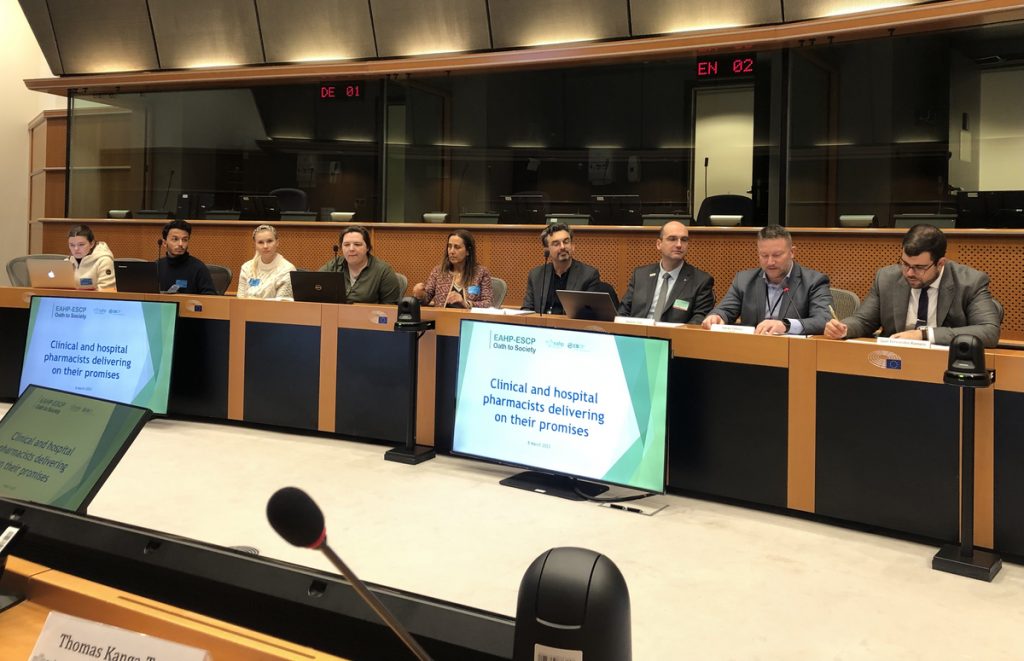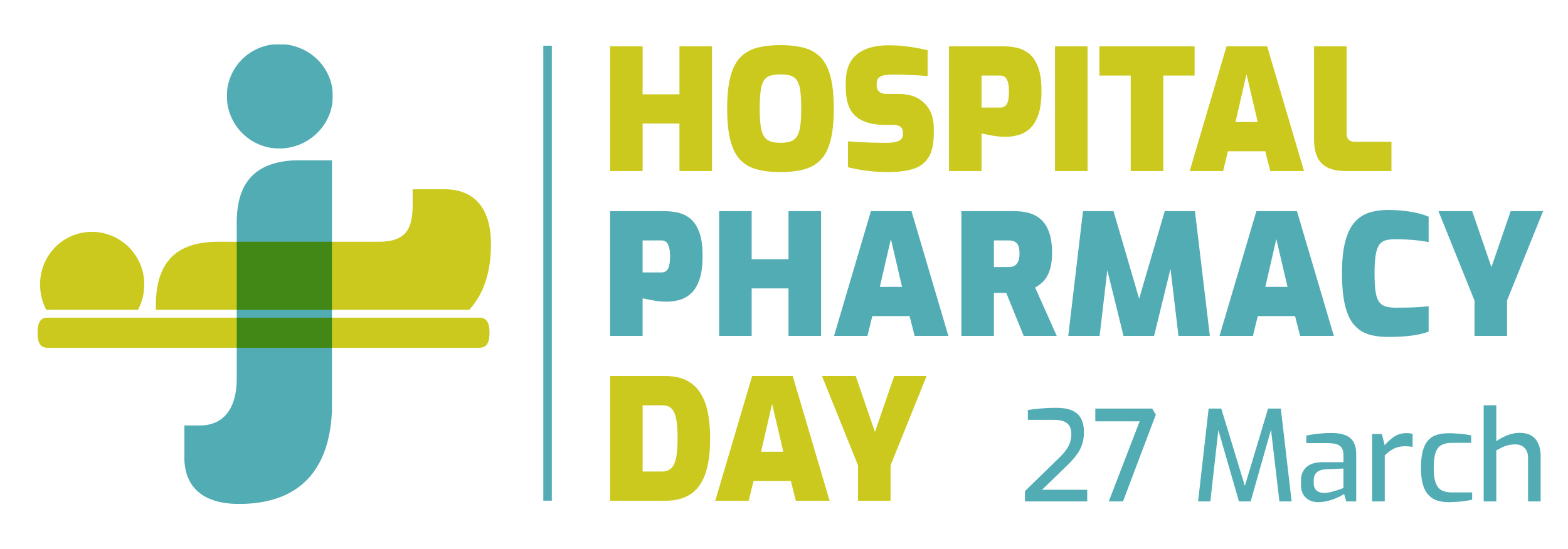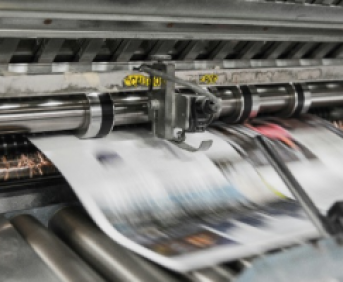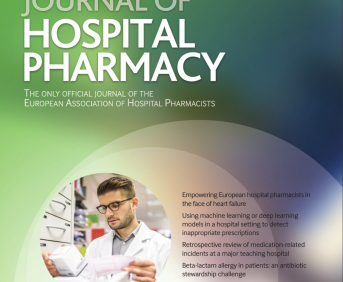THE IMPACT OF A WARD SATELLITE PHARMACY ON CLINICAL PHARMACY SERVICES AND POTENTIAL COST BENEFIET (submitted in 2019)
Pdf

European Statement
Patient Safety and Quality Assurance
Author(s)
Thewodros Leka, iun Grayston, Mashal Kamran, Biljana Markovic
Why was it done?
The Carter report recommended that about 80% of hospital pharmacist time should be spent on the wards to provide clinical pharmacy services. However, in our hospital’s surgical specialty at the time of this report, it was found that only 33% of pharmacist’s time was spent on clinical pharmacy services. This had a negative impact on:
• rate of medication errors and near misses
• supply of critical medicines
• pharmacist participation in productive ward rounds
• timely discharge of patients home
What was done?
The Pharmacy department made a successful business case to the Hospital executives to open a Satellite pharmacy to serve 4 surgical wards. The proposal was to recruit a dedicated clinical pharmacist and Medicines Management Technician, and set-up a dispensing satellite pharmacy.
How was it done?
The business case indicated that if funded, the new satellite pharmacy team would: • improve clinical pharmacy key performance indicators • improve patient safety • deliver a potential cost benefit Funding limitation was an obstacle and we have to convince the board.
What has been achieved?
We achieved 60−90% improvement in the objectives set in the business case as illustrated in Table 1 and 2. The pharmacy team won the annual quality improvement award of 2018. Table 1: Clinical Pharmacy Service improvement Clinical pharmacy services Service rate pre-satellite pharmacy Service rate post satellite pharmacy % of service improvement Medication errors 16/month 6/month 63% Pharmacist interventions 20/month 80/month 75% Pharmacist participation in ward round 6/month 50/month 88% Time to dispense discharge summaries 90 minutes/discharge summary 20 minutes/discharge summary 77% Number of patients counselled 15/month 75/month 80% Pharmacist available in the ward 1.5 hrs/day 7.5 hrs/day 80% Time taken to supply critical medicines 1 hour 5 minutes 91% Table 2: Potential Cost-benefit savings achieved Activities Cost-benefit savings/year (€) Reducing length of stay of patients €17,000 Reducing repeat dispensing €16,000 Effective use of nursing time €11,000 Reducing prescribing errors €103,000 Total Savings €147,000.
What next?
• Weekend working.
• Service improvements can be transferred to acute medical units and downstream medical wards. Reference Carter report.
IMPLEMENTATION OF A MEDICATION SAFETY AGENDA AT TWO HOSPITAL SITES IN RESPONSE TO WORLD HEALTH ORGANISATION (WHO) PATIENT SAFETY CHALLENGE ‘MEDICATION WITHOUT HARM’ (submitted in 2019)
Pdf

European Statement
Patient Safety and Quality Assurance
Author(s)
Meenal Patel, Sheena Patel, Peta Longstaff
Why was it done?
• Initiative introduced and on-going since 2017
• To increase and embed medication safety awareness
• To address under-reporting of medication-related incidents, with feedback
• To embed medication safety in education programmes and clinical practice
What was done?
A local medication safety agenda implemented across two hospital sites in response to World Health Organisation (WHO) patient safety challenge ‘Medication without Harm’.
How was it done?
• Medication safety group (MSG) introduced with local strategy, involving junior medical staff for frontline feedback • Medication safety metrics changed to allow benchmarking with peers as per NHS Improvement’s Model Hospital data • ‘Plan, Do, Study, Act’ model applied to improve transfer of care from hospital to rehabilitation unit following external incidents • Monthly analysis of incidents with harm, exploring reasons for under-reporting • Optimisation of incident reporting system to improve staff feedback following investigations • Near miss error log introduced in pharmacy with shared learning • Mitigation of medication-related risks e.g. medications safe storage action plan • Medication safety bulletins, patient safety newsletters and top tips guide introduced covering focal themes • ‘Safe prescribing’ mandatory induction training for junior doctors to support prescribing of high risk medicines and compliance to patient safety alerts • Hospital-wide education on lessons learnt from incidents • Medication safety resources for staff to access • Nursing quality round on medication safety • Electronic missed doses realtime report developed to tackle omitted/delayed critical medication doses • Medication safety awareness (MSA) week held to increase awareness on focal themes
What has been achieved?
• Multidisciplinary MSG with assurance on meeting WHO global challenge. • Monthly analysis of medication safety data to allow learning, collaboration and benchmarking against peers. • Positive staff feedback on bulletins/newsletters with staff involvement/engagement. • Training programmes embedded with safe prescribing education. • Improved hospital safety metrics: Following MSA week, a 5% and 21% increase in medication-related incident reporting occurred at each site which has been sustained. Reporting rates doubled at one site following success of MSA week. • In 2018-19, local target achieved for reported medication-related incidents per 100,000 finished consultant episodes and medication-related incidents with harm
What next?
• Collaborative multidisciplinary working raising the profile of pharmacists acting as medication safety officers
• Implementing medication safety measures from NHS Patient Safety Strategy 2019
• Initiatives for safer culture, safer systems and safer patients
DEVELOPMENT OF AN INTERNATIONAL EXCHANGE PROGRAMME IN HOSPITAL PHARMACY PRACTICE (submitted in 2019)
European Statement
Education and Research
Author(s)
Agnes Ann Feemster, Nicoletta Zallocco, Carlo Polidori
Why was it done?
Development of pharmacy education on a global scale is an international initiative. Additionally, employers recognise that global experiences positively impact a variety of applicant qualities, including curiosity, willingness to take risks, a non- judgmental attitude, and a broader worldview. The goal of this collaboration is to expose students to the medication distribution system and role of the pharmacist in an international practice setting with an aim of developing a more well-rounded, culturally aware pharmacist.
What was done?
A partnership between the University of Camerino (UNICAM), Camerino, Italy and the University of Maryland School of Pharmacy (UMSOP), Baltimore, Maryland, USA was formed. Under the agreement, the two universities exchange student pharmacists for five-week internships in hospital pharmacy.
How was it done?
A memorandum of understanding was implemented between the two universities in May 2018 with the first UMSOP student visiting in September 2018. A professor from each university co-coordinates the internship. UMSOP students self-fund travel while UNICAM students self-fund and seek university support; funding is a barrier to pursuing the experience. Housing logistics for the students is also challenging. UMSOP students receive academic credit for the experience, requiring that the Italian site meet the advanced practice experience objectives.
What has been achieved?
The programme intended to exchange one-two students annually. After the inaugural student, eight UMSOP students pursued the UNICAM internship, resulting in six student placements at three Italian hospitals. One UNICAM student pursued a cardiology experience at an academic medical centre in Baltimore. UMSOP students perform a preceptor and site evaluation after the internship. 100% of students completed the evaluation with an overall evaluation score of strongly agree that the preceptor and site provided a positive experience. A structured interview with the UNICAM student indicated a greater understanding of clinical pharmacy practice and the role of a pharmacist on an interdisciplinary team, which may be used to further develop hospital pharmacy services in Italy.
What next?
This international exchange demonstrated a high degree of satisfaction among participants. While currently limited to students, this initiative should be considered for practising pharmacists. Sharing of best practices and the interchange of ideas may generate practice enhancements, lead to innovations, and stimulate personal growth.
COMPENDIUM OF POST-GRADUATE ITALIAN HOSPITAL PHARMACY SCHOOLS: AN INFORMATIONAL GUIDE OF ReNaSFO ASSOCIATION – NATIONAL NETWORK OF ITALIAN HOSPITAL PHARMACY SCHOOL STUDENTS (submitted in 2019)
Pdf

European Statement
Education and Research
Author(s)
ANTONIO PIRRONE, FEDERICA MILANI, LUCA CANCANELLI, VALENTINA MARINI , DANIELE MENGATO , ROBERTO LANGELLA , NICOLA REALDON
Why was it done?
On October 5, 2017 the National Network of Italian Hospital Pharmacy School Students (ReNaSFO) was born with the aim to face the various critical aspects of post-graduate Hospital Pharmacy School (SHP), such as the need to make the different paths homogenous among regional SHPs, improve dialogue between colleagues and encourage a more informed approach focused to the training pathway for specialisation. In particular, little official information is available and hard to find about the different realities present in Italy.
What was done?
“Compendium” project is designed to fill this lack and to gather information on post-graduate SHPs operating in Italy. In addition to outlining a summary description of the SHPs, the Compendium is configured as an official tool to respond and provide targeted information to near-graduates and graduates in Pharmacy (who often contact ReNaSFO) interested to approach the SHPs path.
How was it done?
Two project coordinators prepared a list of items submitted to representative ReNaSFO student in every 21 operating SHPs. The items refer to: available places and admission requirements, type of entry test, organisation of didactic lessons, exams and residency training, health facilities affiliated with SHP, potential availability of scholarships, useful links of the SHP or university. The help of universities was fundamental, in particular the helpfulness of SHP directors to collaborate with students.
What has been achieved?
As many as 18 SHPs out of 21 (85.71%) have joined the project: Bari, Bologna, Catania, Catanzaro, Camerino, Genoa, Florence, Milan, Modena and Reggio Emilia, Messina, Naples, Padua, Parma, Pisa, Rome, Siena, Turin and Sassari; of these, 14 schools have already sent their finished “Compendium” form.
What next?
Thanks to the widespread presence of associated ReNaSFO students, the initiative has immediately found interest and participation, reconfirming once again the active and unconditional collaboration between SHP students throughout Italy. Despite a heterogeneous situation between different SHPs, we keep working together hopeful to achieve national uniformity of SHPs and to improve educational objectives and training pathways.
COMPREHENSIVE SMOKING CESSATION PROGRAMME RUN BY CLINICAL PHARMACIST IN COLLABORATION WITH THE ADDICTOLOGY DEPARTMENT
Pdf

European Statement
Clinical Pharmacy Services
Author(s)
Mathilde ROCHE, Niccolo CURATOLO, Marion ADLER, José POLO DEVOTO, André RIEUTORD
Why was it done?
Many smoking patients are not identified as smokers when admitted at the hospital, depriving them of any help to quit smoking. During medication reconciliation at admission (MR), the pharmacist is in a position to identify smoking patients and then offer a support programme.
What was done?
An integrated care model based on a smoking cessation programme was designed to assist smoking patients to quit tobacco. Pharmacy and addictology departments co-built and led the project. It was implemented and proposed to patients from May 2018 in three medical and surgical wards.
How was it done?
The project included five steps:
1. Training of one clinical pharmacist about smoking cessation by the addictology team.
2. Designing the process and developing tools used for a smoking cessation programme.
3. Implementing the programme.
4. Evaluating the pilot phase.
5. Developing a comprehensive training programme (including role-play sessions) for the pharmaceutical team.
The process counted six steps:
1. Smoking patients’ identification (MR, patient record, request from doctors). If the patient was polyaddicted, the addictology team was informed.
2. First patient visit: patient consent was collected, anamnesis related to tobacco and explanation about nicotine’s mechanisms and nicotine substitutes given. Appropriate nicotine substitutes were selected and tested with the patient.
3. Prescription and administration of nicotine substitutes.
4. Second patient visit (24 to 48 hours’ later): nicotine substitutes adjusted if needed.
5. Third patient visit if needed.
6. Discharge medication reconciliation.
What has been achieved?
During 4 months, 62 patients were identified as smokers during MR interviews. Twenty-seven per cent of the patients (n= 17) were sent to the addictology team because of polyaddiction, 39% (n=24) refused the programme and 34% (n=21) accepted to experience our support programme. Of these, 62% (n=13) either reduced or quit smoking during hospitalisation.
What next?
According to our encouraging preliminary results, this programme will continue to be carried on by the pharmaceutical team, while keeping a close link with the addictology team. We decided to call the patients one week and one month after discharge to better assess the performance of our smoking cessation programme.
EVALUATION OF THE IMPACT OF PATIENT EDUCATION WORKSHOP ON CARDIOVASCULAR PATIENTS USING THE SELF-EFFICACY CONCEPT
Pdf

European Statement
Education and Research
Author(s)
A Schils, S Pochet, B Allenet
Why was it done?
The aim of this study was to test the ‘self-efficacy’ concept in order to assess the impact of the session on self-management, once the patient finishes the workshop. The evaluation took place from 1 March 2018 to 31 May 2018.
What was done?
The Grenoble University Hospital Centre has set up a therapeutic education programme in the after-care and cardiac rehabilitation department. Indeed, different educational workshops are offered to the patients on various subjects such as disease, treatment and prevention. The workshop ‘medication’ run by the pharmacist addresses the concept of benefit-risk balance, self-medication, drug mechanisms of action and daily medication. Each group integrates 10 to 15 patients, once a week.
How was it done?
Before and after each workshop, a questionnaire evaluating self-efficacy was filled out by each patient, on 10 modalities likert scales: I felt capable of…:
1. Explaining why I am hospitalised.
2 Explaining to my friends and family what my different medications work on.
3 Taking my medication as prescribed.
4 Manipulating each of my medications (reading instructions, opening bottles, breaking blisters…).
5 Explaining to my friends and family the hazards of self-medication.
6 Discussing freely with my physician all of my problems.
What has been achieved?
Fifty-two patients answered the questionnaire. Statistically significant difference before and after the workshop were observed for questions 2, 5 and 6 using a Student’s t-test. Individual results helped us target patients with specific difficulties, who were seen afterwards, during an individual consultation.
What next?
Self-efficacy assessment can be used as a ‘normative’ way of testing an educational sequence (what works and what doesn’t work?) and also as a ‘clinical pharmacy follow-up tool’, selecting patients experiencing specific difficulties with their treatment.
IMPROVING INVESTIGATIONAL DRUG MANAGEMENT: AN INNOVATIVE PROCESS
Pdf

European Statement
Clinical Pharmacy Services
Author(s)
Francesca Vecchione, Melania Rivano, Patrizia Tadini
Why was it done?
The new process was developed in order to face the significant increase of ID management assigned to the Pharmacy, along with the logistic problems due to the several areas of storage, dispensing and administration. Additionally, it allowed to assure the effective use of ID reducing the risk of failure and improving the patient safety.
What was done?
The Good Clinical Practice guidelines establish that the principal investigator (PI) can delegate the investigational drug management to a pharmacist. In our university teaching hospital with a large amount of clinical trials (CT), pharmacy service proposed an optimisation of ID (investigational drug) management through the elaboration of a form to request the ID. Along with this, we assigned each protocol to a specific type of management and we created an intranet site from where healthcare professionals can download the form.
How was it done?
The pharmacy service created for each CT a specific form organized into 5 sections. Section A, B and C were filled up with protocol information (name, centre code, PI) patient data (initials, patient code) and the treatment schedule. Section C, completed by data manager, showed the quantity of drug to be dispensed and the expected day of administration. Section D was completed with batch and expiry date. The form had to be signed by the pharmacist at the moment of the dispensation and signed back by the committed person who took it. Section E reminded the type of management assigned to the protocol. Five different types of management had been identified, based on the characteristics of storage, the activities required by the protocol (IWRS, unblinded pharmacist, drug preparation) and the dispensing method.
What has been achieved?
Data from January to June 2017 attested 60 ongoing protocols, 722 dispensations for patient, 237 drugs prepared by pharmacists and 986 in Chemotherapy preparation unit. The development of the new procedure ensured the ID tracking, the overcoming of logistical difficulties and an increase of the safety.
What next?
We are going to keep on improving the pharmacist role in CT by ensuring ID are handled, stored and correctly managed. The objective is to enhance the collaboration of clinical research professionals in the management of CT.
PHARMACISTS ROLE IN THE DEVELOPMENT OF A THERAPEUTIC PATIENT EDUCATION (TPE) PROGRAM BASED ON THE DIRECT ACTING ANTIVIRALS (DAA) USED IN CHRONIC HEPATITIS C TREATMENT.
Pdf

European Statement
Clinical Pharmacy Services
Why was it done?
It is now usual to dispense hepatitis C DAA to outpatients, whose virological success rate is high in the general population. However, subpopulations are at risk of re-infection or noncompliance for which an individualized approach with TPE is required. Role of the pharmacist is to transmit skills for starting and to assist the patient during treatment. SE are sometimes more easily disclosed to pharmacist, thereby allowing to take them into account so that the treatment can be adapted until completion. TPE benefits for these subpopulations are expected in the short term with regards to compliance and empowering the patient during treatment and in the long term to eliminate risky practices and leaving additions.
What was done?
setting up and running TPE sessions for hepatitis C by pharmacists
How was it done?
Hepatology department, based on multidisciplinary team (hepatologist physicians, psychiatrists, addiction specialists, pharmacists, nurses and psychologists), developed a TPE program on viral hepatitis in april 2016. Following written consent, entry into the program was systematically offered to vulnerable patients (background of substance abuse, active alcohol consumption, risk of non-compliance).
Pharmacists were involved in individual sessions concomitantly to DAA dispensing, since the day when patient started TPE program. Pharmaceutical sessions aimed outpatients to acquire following competencies:
– DAA’s name, action mechanism,
– Terms of administration, what to do if forgotten,
– Side effects (SE) and their management,
– Drug interactions (adapted to outpatient treatment).
Pharmacists also answered to questions concerning the patient and monitored compliance and SE.
Interactive practical tools were developed: treatment logbook (also allowed evaluating objectives at each session), cards about known and preconceived SE, timetable for drug intake. Patients fulfilled a satisfaction survey at last session.
What has been achieved?
31 outpatients were included. Pharmacists conducted 65 sessions, 2 or 3 individual meetings per patient (one hour-long total per pharmaceutical session) depending on treatment length (8-24 weeks). 6 patients were still ongoing and 25 achieved the program. Among them, 12 had an undetectable viral load after 12 weeks (Sustained Virological Response 12) and 1 relapsed. 100% of goals were achieved as from the first pharmaceutical session. 100% of patients were satisfied about pharmaceutical session
What next?
Evaluation of program’s benefits in terms of virological success need to be continued.
OPTIMIZATION OF INTRANET COMMUNICATION TO THE CLINIC
Pdf

European Statement
Education and Research
Author(s)
Nina Kærgaard Hansen
Why was it done?
The initiative was performed to investigate the accessibility and usability of the current intranet in order to improve intranet information and communication from the hospital pharmacy to the clinic.
What was done?
Workshops with usability tests were performed with four different professions who are expected to use the intranet information and communication from the hospital pharmacy.
How was it done?
Workshops for selected professionals including pharmacists, pharmaconomists and nurses were held. The workshops consisted of four parts:
1. Video capture and recording test: Participants were asked to find specific information on the intranet. Comments, clicks and movements of the mouse were recorded during the task.
2. Sorting and prioritization the pages: Participants were given screen shots of 57 pages from the intranet. The participants were asked to sort the pages in three categories: need to know, nice to know and insignificant.
3. Evaluation of selected texts: Participants were given 5 examples of texts from the intranet and asked to assess if the text was relevant and understandable.
4. Structured focus group interview: Using a structured interviewguide the use and challenges experienced by the participants were explored.
What has been achieved?
From the present initiative it was found that the structure of the intranet was not optimal and did not reflect the daily needs from the users. The results from the workshops provided a clear guideline on how to restructure the intranet. It is important to make short cuts and optimize search function.
In addition, the initiative revealed how to improve texts:
– Write shortly, concisely and action oriented: “Tell us what to do”.
– Write the most important first, then elaborate and insert links to learn more.
– Use subheadings for skimming the text.
What next?
A campaign is planned to advertise the new intranet structure. Number of users and subscribers on the intranet pages is followed to see if the activity increases. Editors have been educated to write texts that are short, concise and written in an action oriented language
USE OF TECHNOLOGIES IN THE TRAINING OF PHARMACY STAFF
Pdf

European Statement
Education and Research
Author(s)
VIRGINIA SAAVEDRA QUIRÓS, BELÉN ESCUDERO VILAPLANA, ELVIRA SANTIAGO PRIETO, MARÍA BELLA CORREDERA GARRUDO, INÉS GUMIEL BAENA, MARÍA DOLORES GARCÍA CEREZUELA, AMELIA SÁNCHEZ GUERRERO
Why was it done?
It is important to provide continuous training to all professionals working in the healthcare system, especially when staff turnover is frequent, and when their job is directly related with drugs management, where a failure in the chain of drug utilization can have an impact on patient health.
What was done?
We developed a technology-training strategy of the Pharmacy Department to improve the training resources of the professionals working in it, through the support of information and communication technologies (ICTs), in order to achieve the highest quality in our actions.
How was it done?
The initiative was targeted at the nursing assistant staff of the Pharmacy Department, in the dispensation process to in-bed patients. The development period was between March and April 2017, focusing on activities related to the management, conservation, storage and dispensing of medicines.
This information-training material was developed as follows:
‐ By editing video-tutorials, which would be accessed after recognizing an associated QR code.
‐ Through the preparation of summary sheets in poster format that reflect in a schematic, concrete and visual way those key aspects in each of the processes.
After its implementation, a user satisfaction survey was conducted to evaluate the initiative.
What has been achieved?
Five training video-tutorials were made on different subjects: preparation of unit-dose dispensing carts, preparation of medication from automated dispensing systems (ADS) in Pharmacy, order reception, replenishment ADS in the wards and preparation of medication “on demand”. The average duration of the videos was 5 minutes 45 seconds.
In addition, 7 summary sheets were designed for the management of other types of activities: returns, expirations, special orders, priorities in normal situation – critical situation, management of medicines not included in pharmacotherapeutic guide, interhospital medication loans and calls procedure in the Unit-dose dispensing area.
Satisfaction surveys conducted by nursing assistants have positively valued the initiative.
The strategy developed allows the integration of ICTs in staff training, helping to manage the information of the Pharmacy Department, achieving a better optimization of available resources.
What next?
The degree of satisfaction of the users was good for what we consider important to promote this practice, making it extendible to the other areas and members of the Pharmacy Department.
